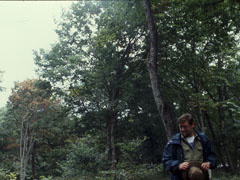忘れ去られた森
C.W.ニコル・アファンの森財団は、会員の惜しみない寄付のおかげで財団の森(20年前に私自身が購入し、現在は財団が管理している)に隣接した数千坪の山林を手に入れることができた。8月の2週目、私と森を管理する松木と石井は、京都大学の数名の学生、教授と共に、この場所を健康な混交林にするため、細長く貧弱な木や立ち枯れている木、病んでいる木を伐採し、来年の春に行なう植樹の準備をしていた。
森の手入れをしていない人の多くは、このような木を切る必要性を理解していない。しばらく私達と一緒に活動してみれば理解できるかもしれないが、重労働で、きつく、危険を伴うこのような仕事を、ボランティアで関わっていただく人たちに求めてはいない。森の作業をするには、枝葉が落ちている斜面での姿勢の取り方や機具の安全な使い方、他の作業者へ注意を払うことなど、安全な環境を確保するための振る舞い方を理解しておく必要がある。または、これらを熟知している者に監督されていることが必要になるからだ。
森にいる間は指導の大部分を松木さんに任せ、私は7本の枯れ木と、細長く曲がって成長したほぼ同数の木を伐採し、片付けていた。木を切るといつもその年輪を観察するが今回私達が切った木々はとても貧弱で、私の首回りと同じくらいの太さにも関わらず、その大部分が樹齢60年前後だった。最後の約30年分の年輪は間隔がとても狭く、つまりほとんど生長していないことを表していた。これらの木は、もやしの様にひょろっとしていて、樹冠がとても小さい。つる植物が幹を締め付け、また樹上に重くのしかかっていた。何本かは冬の雪の重みで幹が曲がり、頭頂部が地面につきそうだった。こうなったのには理由がある。太平洋戦争の終わりにこの土地の木々は一斉に伐採され、植樹後は若木が育ったが、30年程前から間伐やつる切りをしなかった。そのために健康で生き生きとし、豊かであったはずの森は、木々が密生し貧弱な藪になってしまったのだ。材木としても価値がなく、多くの野生生物にとってもほとんど役に立たない藪に。
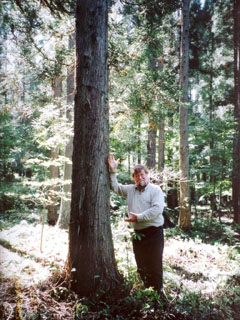
- アファンの森の樹齢約50年の木
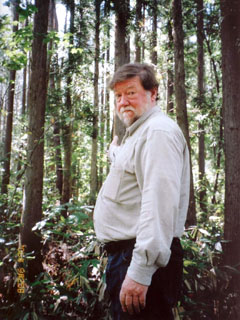
- こちら国有林。樹齢はほぼ同じでもこんなに違いがでる。
年輪は放置した年代をはっきり示していた。私達が買った山林の地主たちは、30年以上もその土地に手を入れようとしなかったのだ。彼らは、単に受け継いだだけである。戦後まもなくに政府からとても安い値段で土地を購入した親から。親達は辛く厳しい時代にも関わらず、できる限り手を入れ保全してきた。しかし、息子達はそうしなかったのだ。
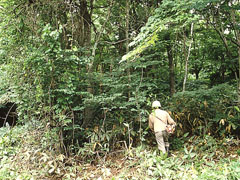
- 購入時の様子。放置され、つるが木々に巻き付くうっそうとした森

- 現在は人と共に生きる空間が生まれている
なぜ受け継いだ土地の手入れをしなかったのか。いつも耳にする言い訳は「土地はお金にならないから」というものである。では聞く。あなたが都市部に庭を所有していたが、雑草やゴミで荒れ放題になるまで放置したとする。近隣の人々に「花や庭木で満たされた素晴らしい庭を維持してもお金にならない、だから世話する価値はない」という言い訳が通用するだろうか? 私はそうは思わない。
日本で山林を所有している人々の多くは裕福だと思う。1週間に数日森の手入れをしてくれる人を雇い、少なくとも何が行われているのか見に行くくらいのことはできるはずだ。皮肉なことに、私が見かける不在地主の大多数がゴルフに大金をつぎ込んでいる! 私にとっては、ばかばかしく軽薄なことで、時間の無駄というものだ!
私達の財団は、多くの時間やエネルギー、労力、それから土地を買うお金も費やし、健康な森に戻すために一生懸命活動しなければならない。いずれは大木が育ち、野生生物にあふれ、多くの水を蓄えることのできる豊かな森に戻すために。私達は、自分達のしていることに誇りを持っている。そして、自分達の活動を信じてる。
森を放置した世代の人々がいる。その次の世代では何が起こってしまうのだろう? “森を放置する”という言葉の意味すら理解できない世代の人々。
71歳になる森林整備の達人、松木さんはいつもこう言っている。「自然保護は放置じゃないぞ!」
C.W.ニコル
長野県黒姫にて
翻訳:吉田昌史
-photo/copy right-
top,4th,5th,6th:Kenji Minami
2nd,3rd:C.W.Nicol
協力−財団法人C.W.ニコルアファンの森財団 http://http://www.afan.or.jp/
A GENERATION OF NEGLECT
The C.W.Nicol Afan Woodland Trust, through the generous donation of a member, was able to acquire several thousand tsubo of forest land in a little valley adjoining the present trust land. Which I myself bought about twenty years ago. In the second week of August, together with a few students and professors of Kyoto University, I and our foresters, Mr.Matsuki and Mr.Ishii, were trimming out spindly, broken or sick trees ready for replanting with a mixture of healthy trees next spring.
Many non-foresters do not understand the need for cutting such trees. If you worked with us for a while you might, but on the whole we don’t encourage volunteers in this kind of task, which is hard, sweaty and dangerous. You either have to know what you are doing – how to take a stance on steep and littered slopes, how to use a tool safety, and to look out for others, or you have to watched closely by somebody who does know.
I left the teaching mostly to Mr.Matsuki whilst actually in the woods. I myself cut down and tidied up seven dead trees, and about as many bent, spindly trees. When I cut a tree I always examine the tree rings. The trees that we cut were all very spindly, about as thick around as my neck, although they were nearly all around sixty years old. The last thirty or so years of annual rings were very close apart, indicating hardly any growth at all. These trees were as spindly as moyashi bean sprouts, with very small upper canopy cover. All of them had been strangled or made top heavy with vines. Several had been bent right over so that their tops were close to the ground, from the weight of winter snow. This was because the land had been cleared of trees at the end of the Pacific War. Young trees grew up in the cleared ground, but as they had not been thinned out since thirty or so years ago, and as the many vines had not been cut, what might have healthy, robust, productive been woodland turned into densely crowded, sickly thicket. Useless for timber and damn near useless for most wildlife.

- in Afan Woodland trust
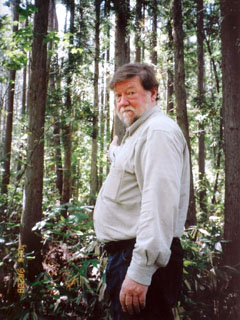
- in a national park
The tree rings clearly showed a pattern of a generation of neglect. The owners of the woodland from whom we had bought the land had not lifeted a hand in their maintenance for thirty years and more. They had merely inherited the land from their fathers, who had obtained the land at very cheap prices from the government soon after the war. Their fathers, despite arduous and difficult times, did their best to husband the land.The sons did not.
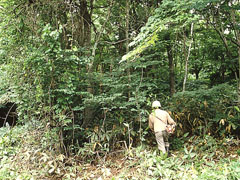
- at the begining of Trust
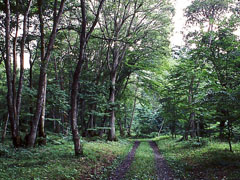
- sharing the nature now
I always hear excuses about why inherited land is not tended, and the usual excuse is that the land will not make money. I ask you, if you have a garden in a city, and you neglect it to grow a wasteland of weeds and garbage, will your neighbours respect an excuse that keeping a nice garden full of flowers and shrubs does not make money, so it’s not worth doing? I don’t think so.
A lot of people who own forest or woodland in Japan are wealthy enough to hire somebody to tend the woods for a few days a week, and to go and have a look at least at what is being done. Ironically enough, nearly all the absentee forest and woodland owners I’ve come across regularly spend a lot of money to play golf! To me, a silly and frivolous waste of time!
Our trust has to work hard, spend a lot of time, energy, sweat and money both to buy this land, and then to start bringing it back to a healthy forest state which eventually yield big trees, wildlife, and an increased ability to hold water. We are very proud in what we do. We believe in what we do.
We have had a generation of neglect. What will happen to the next generation, a generation who doesn’t even understand what ‘forest neglect’ means?
At Matsuki-san, our 71 year old veteran forester is always saying”
“Shizen hogo wa houchi ja nai zo!”
C.W. Nicol
Kurohime, Nagano.
-photo/copy right-
top,4th,5th,6th:Kenji Minami
2nd,3rd:C.W.Nicol
cooperation−The C. W. Nicol Afan Woodland Trust
http://http://www.afan.or.jp/

